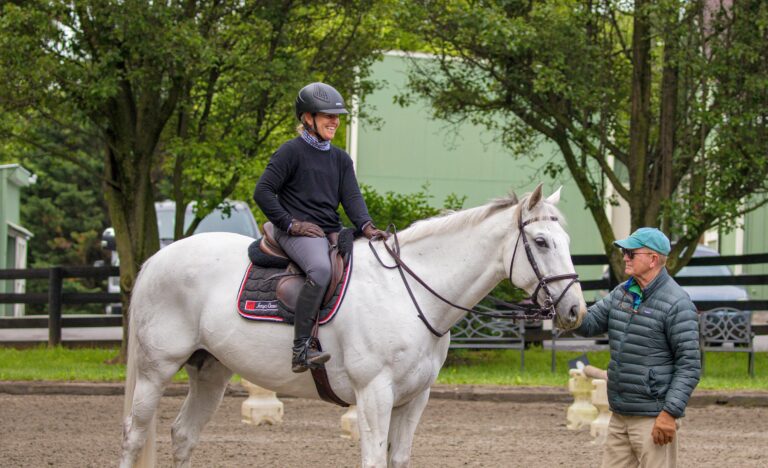After a thought-provoking dressage lesson with Silva Martin and lunch with Silva and her husband, Boyd, Daphne Soares was excited for her cross-country schooling lesson with the 2016 Olympic eventer.
And then her horse pulled a shoe.
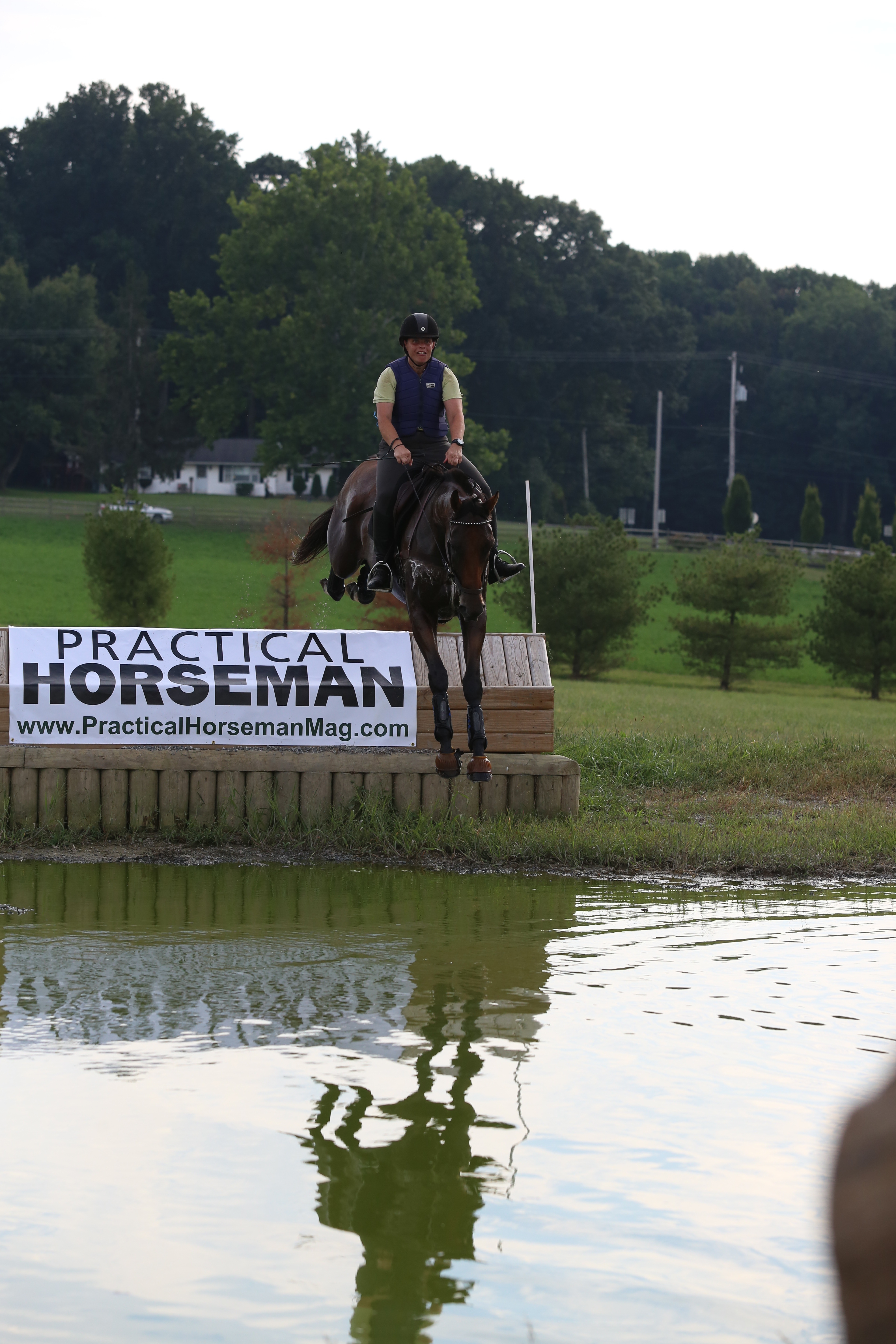
To make matters worse, the shoe was missing, somewhere between the dressage arena and Daphne’s trailer along the driveway at the Martin’s stable, Windurra, in Coatesville, Pennsylvania.
“I can’t believe this,” the 44-year-old amateur eventer said as she walked along the grass looking for the shoe. Daphne had won Practical Horseman and Dressage Today’s Win A Day Clinic, sponsored by Purina, and she, along with her son and six friends had trailered their horses to the Martins. Daphne eventually found the shoe and farrier Doug Neilson put it back on in time for her lesson with Boyd.

More than 700 applicants had entered the Win A Day contest by explaining why they should enjoy a day of coaching for themselves and up to nine friends with Boyd, a member of the U.S. Eventing Team who competed at the Rio Olympics and was also on the squad that won team gold at the 2015 Pan Am Games, and Silva, a Grand Prix dressage rider who represented the United States on the gold-medal-winning team at the 2014 Nations Cup in Wellington, Florida. In her essay, Daphne, of Long Valley, New Jersey, wrote, “Because I just turned 43 and still get excited—every single day—about riding, like I was a kid; because I was a show jumper, then dressage rider, who found eventing in the last 10 years and became even more excited about riding (if that is possible); because I have the horse of a lifetime.”
Daphne and her friends spent the morning working on dressage with Silva and the afternoon schooling cross country with Boyd (read about the dressage portion of the clinic in Dressage Today’s January 2017 issue). Everyone enjoyed lunch together as Boyd told stories about his recent Olympic experience. Split into three groups based on experience, the riders headed out to the cross-country schooling course with Boyd after touring the barns to meet some of his world-class event horses, including his latest Olympic partner Blackfoot Mystery, as well as Welcome Shadow, Crackerjack, Shamwari, Remington XXV and Neville Bardos.

Let the Horse Do the Work
Boyd started the first cross-country session by having the three riders, who were at Beginner Novice and Novice levels, adjust their galloping position at a standstill so they were balanced over the horses’ withers and shoulders instead of their backs. “Stand in the stirrups,” he told 11-year-old Tzur Haspel-Soares, Jen Garutti and Deena Cahill. “Don’t do the ‘saddle clunk.’ You don’t want to fall back and then clunk into the saddle, and while you’re galloping you don’t want your seat resting on the back of the saddle.” (See sidebar, “Riding Efficiently”.)

Tzur, Jen and Deena practiced the correct galloping position by cantering around Boyd’s all-weather galloping track, maintaining a steady rhythm. He encouraged them to go at an appropriate Novice or Training speed and try to relax and keep a steady rhythm in self-carriage. “Galloping in a rhythm is similar to dressage or show jumping in that we want our horses in a steady balance where we’re not holding them up or pulling back on them,” he said. “We want them to just go at a steady rhythm and hold the pace on their own.”
Once this was established, the riders hopped over a small log as a warm-up fence. “Your goal over tiny fences is riding out of a rhythm and doing as little as possible to influence the horse,” Boyd said. “Practice not being control freaks!”
After jumping bigger fences while focusing on balance, they moved on to three side-by-side ditches of varying sizes. Boyd first had them walk their horses around the ditches, an exercise he said he learned in Australia from his mentor Heath Ryan. “This helps the horse understand where the takeoff and landing are,” he explained.
“Basically on cross country when you’re approaching an open-faced ditch, the worst possible scenario is the rider leaning forward in a beautiful crest-release position, then the horse coming to a screaming halt and the rider landing face down in the ditch,” Boyd said. “We have to ride in a defensive position where in a worst-case scenario we can stay in the saddle. Remember, the horse only has to jump across the ditch—there’s no height to it. So we want a little bit longer rein so the rider’s body can shift behind the center and should the horse start to question the open ditch, the rider can instantly drive forward with the leg and seat and the shoulder is behind the hip. With the longer rein, you can use the stick behind the leg without letting go of the rein. All these forward-driving aids are used to encourage the horse to jump across the open obstacles.”
As Deena cantered the ditch, Boyd reminded her to “keep your hands at the top of the thigh and lean behind the motion over the ditch. Don’t thrust your body on the last stride. Let her do the work for you.”
From the ditches the group moved on to the drop steps. “Down the steps, lengthen the rein and stay behind the motion,” Boyd said. “At the canter, the last step before the drop is almost a trot because the stride after the jump is where you might get pitched forward. Obviously, you don’t want to look down. Keep your eyes ahead, your leg on and your shoulders back as you slip the reins.”
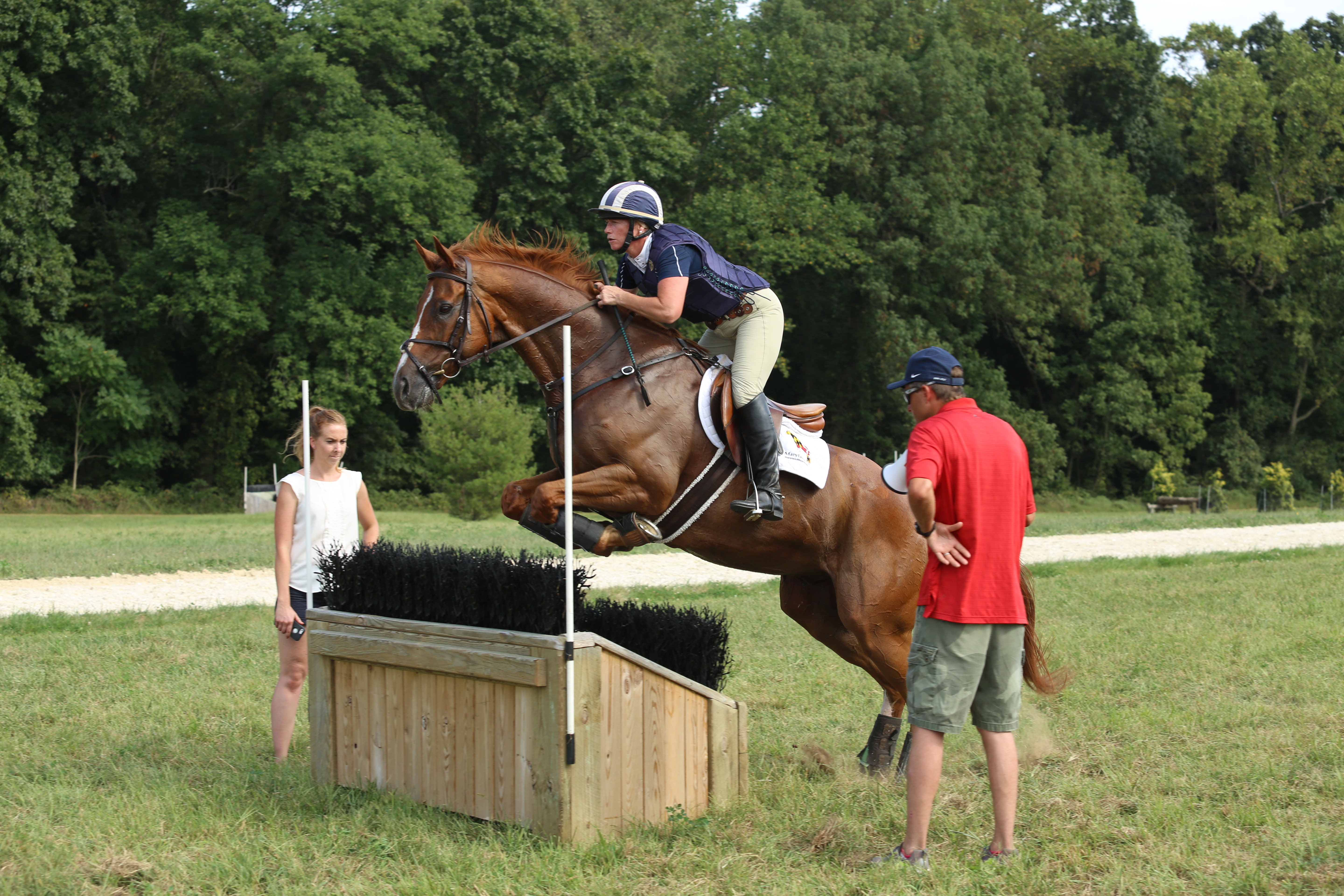
The group finished with the water jump. They walked, trotted and cantered through the water and jumped a couple of small fences in and out. “Like many other cross-country obstacles, the water relates to confidence,” said Boyd, explaining that he also learned his approach to water fences from Heath. “What the horse must understand is that every time he’s faced with water, the water is only 3 inches deep, not 3 or 4 feet deep. The horse could relate it to a lake or a dam, but he needs to learn it’s only ankle deep. Walking through the water over and over to start with will teach the horse this. The moment the horse goes from dry ground to water is when he is most unsure and nervous and edgy, so we’ve got to repeat that over and over until he goes from dry land to water without that nervous twitch. I go in and out of different parts of the water, even up and down a little bank until the horse isn’t freaking out. Once you’re in the water there’s no real benefit to walking around and around—it’s getting in the water that is the challenge we’re faced with on cross country.”
He pointed out, “In our particular water we’ve got a really baby-sized up bank that’s only about a foot high. The horse can sort of get up it and misread it but not scare himself. In my opinion, the up bank out of water is the most treacherous. It’s hard for the horse to measure it because he’s reading the distance from the top, or surface, of the water to the top of the bank while in reality the ground level is a few inches below the water. A lot of young, inexperienced horses trip going up out of the water, so it’s important to teach young horses by going up and down repeatedly until they learn that the bank is slightly taller than it looks.”
Rhythm and Building Confidence
The second group was schooling at Training level. One of Boyd’s first comments once the group started was to let the horse register the jump and then press him forward.
When Rumsey Keefe’s horse stopped at a narrow fence, Boyd formed a wall with his body to help prevent the horse from running out again. “He’s green, but you have to get rid of the hesitative chip in front of the fences,” Boyd instructed. “Don’t let him fall behind your leg in the turn. When you decide to go, he has to go. If you need to, use the stick to make him react to your leg. When you’re on cross country, you can let your reins be slightly longer so that your body can stay back slightly in a more defensive position.”
Nancy Seybold’s horse has historically not been a fan of jumping ditches, so Boyd made a plan of attack. Like the first group, these riders walked around the ditches a few times in preparation. He advised Nancy to make a bold approach to the ditch that would leave her horse no choice but to jump over it. “The first time I want you to approach with a lot of momentum, give it 100 percent,” he said. “The next time through you can come at 80 percent, then at 70 percent and so on so that the horse has more time to consider the jump and learn from the experience. The first time over it, though, I want you to ride like a lunatic: full on with long reins to give your horse room to jump without you snatching him in the mouth and your stick ready in case he hesitates.
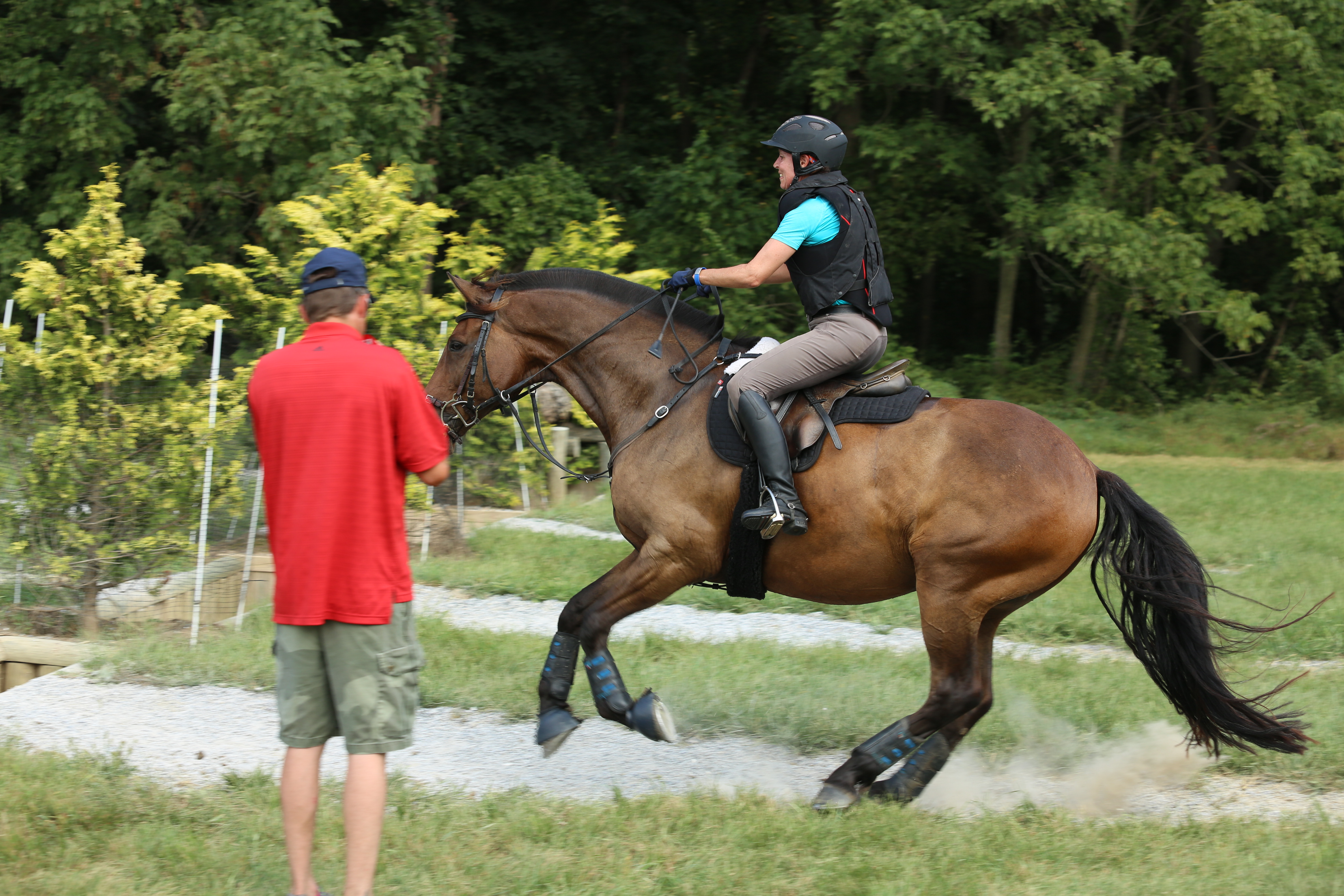
“You want to avoid going to war with him,” he told Nancy. “Just get him over it the first time and then start the toning-down process because there is no second try. Once he gets the idea that it’s OK to stop, you’re already on the defensive.”
The horse jumped and Nancy whooped and hollered with excitement, then Boyd told her to tone it down for the next approach—but not to back off completely. After the gelding jumped the ditch a few more times, Boyd had Nancy walk, then ease into a trot just before the ditch so that the horse could get a good look at the jump and really understand the exercise.
After schooling different fences, the session wrapped up at the water complex, where the three riders took various approaches to jumps into and out of the water and a cabin in the middle of the water. Ryan Keefe’s horse took a huge leap over the cabin, allowing Boyd to talk about keeping a steady rhythm through the whole complex. He encouraged the riders to focus on accuracy and staying strong to the fence.
At the conclusion of this session Boyd went over his wish list for the riders:
“At the top of the list is rhythm,” he said. “At this level I’d rather see [the fence] completely wrong than changing too much. Consistency is the key.”
He also wanted to see the horses react to their riders’ aids. “When you touch the horses with your leg or spur, they should go,” he said. “They’re all a little unreactive to the leg, and if you don’t have that on cross country, it’s dangerous. The worst falls are when you or the horse hesitates. In warm-up it’s always important to work on your horse reacting to your leg.”

He also discussed the importance of gradually building a horse’s confidence on cross country. “Basically with cross-country schooling, different to a competition, we’re out there really educating our horses and trying to get a true understanding of what we’re doing,” he said. “It’d be very rare for me to go out and gallop around and jump every jump. On a good schooling course there’s a small, medium and bigger ditch. You wouldn’t just race at the big ditch straight off, you’d start with the small one, then slightly bigger and eventually jump the bigger fence. It’s the same with banks, even combinations like the water and sunken road. We want the horse to understand each element before you point him through ABC all at once. That way we’re teaching the horse what’s coming up before he puts it all together. Ultimately we’re trying to avoid the horse having a runout or stop, and always jump clear. Even if we’re exposing them to the second part of the challenge first, I think it’s more important to have a positive school with no stops, and keeping things simple is the best mode of progression.”
Daphne’s One-On-One Lesson
As the second group of riders was working with Boyd, Daphne realized that her 6-year-old off-the-track Thoroughbred, Anakin, had pulled a shoe. Luckily, farrier Doug Neilson was working nearby at eventer Ryan Wood’s farm, so Daphne put Anakin in her zebra-striped horse trailer and hauled him over. Doug put the shoe back on an excited Anakin, who wasn’t crazy about leaving his friends, and Daphne made it back to Windurra in time for the one-on-one school she’d requested so she could work on Preliminary/Intermediate-level fences.
Boyd had Daphne, a professor of evolutionary neurobiology at the New Jersey Institute of Technology, start with a couple of warm-up fences and then got down to some more technical exercises like the corner, steps and coffin. He had her work on keeping her position consistent on the approach and landing and also to “think about your line after the jump. Ride the galloping fences out of stride and if you need to organize for a technical fence, shorten the stride to a coffin canter, which is the slower, very organized canter that you would use riding into a coffin, or a vertical–ditch–vertical combination.”
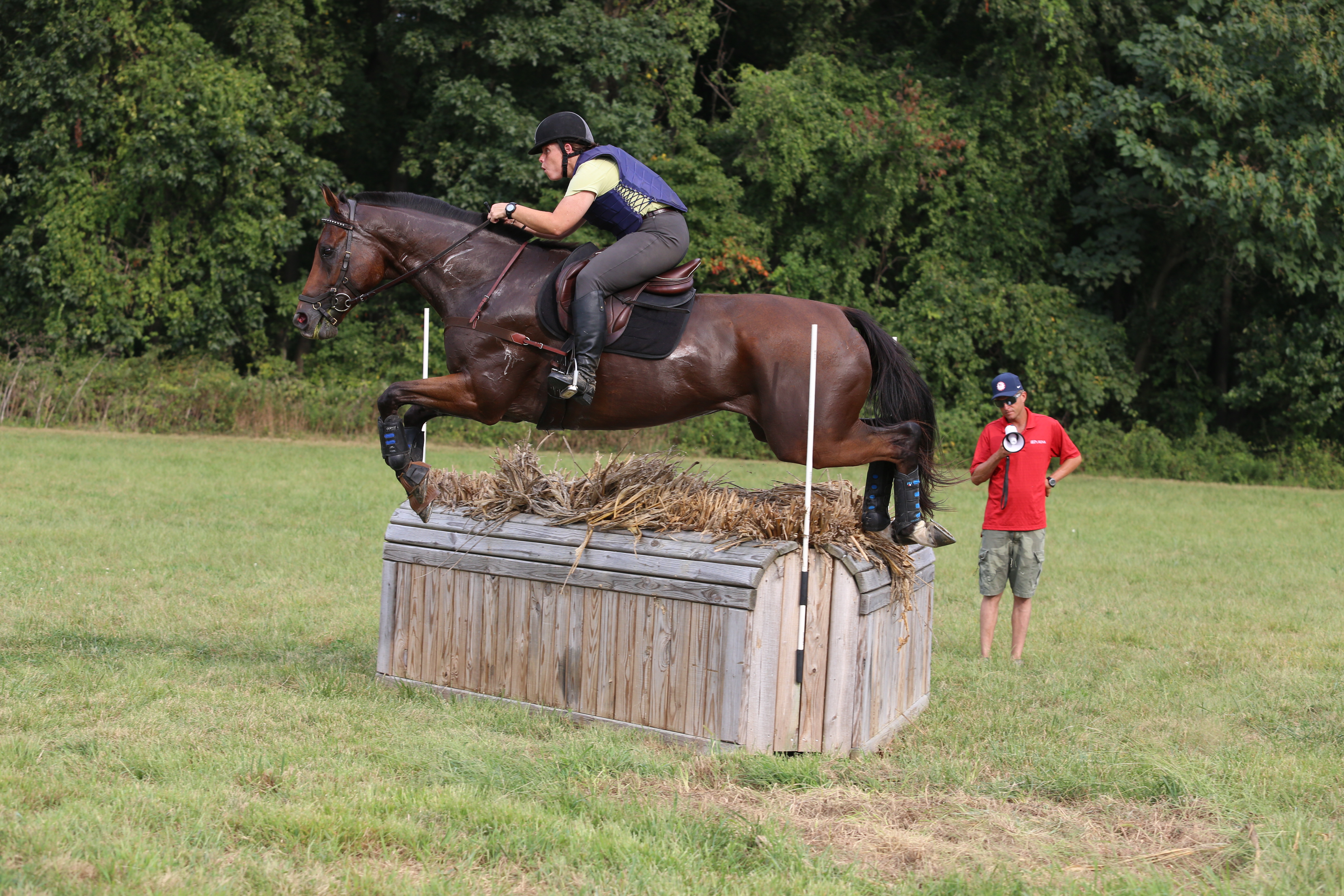
He also observed that Daphne tipped forward on the landing and cautioned that this habit would really cause problems on drop fences, where sitting back helps the rider keep from tipping right out of the saddle. Jumping a skinny fence to another skinny fence downhill and on a curved line, Daphne was forced to sit back in the saddle to use her seat effectively and keep Anakin on the line.
“Daphne has a very good horse,” said Boyd, who praised her for giving Anakin a positive ride. The session was shorter than the others, but Boyd said that when a horse is willing, a lot can be accomplished in a little amount of time.
As Daphne cooled out Anakin, Boyd said, “This whole clinic was lovely. Silva and I really enjoy having people bring their horses to our home, and it was also great to show everybody how we go about our day and how we train. We are grateful to Purina for sponsoring the clinic as well. It’s good for our sport because professionals and amateurs are competing at the same events and it’s great to build connections with people.”
Sidebar: Riding Efficiently
Boyd Martin shared some thoughts after the clinic about the galloping position: “Basically you can ride pretty badly and still make the time and win the class at Novice and Training level, but one of the goals is riding efficiently and evenly and seeing how easy we can make it for our horses to go cross country.

“The biggest fault I see at the lower levels is riders balancing their position too much over the horse’s back rather than over the horse’s shoulder. This often leads to the rider’s backside bumping the saddle because, even though the rider is in a forward seat, their weight is too far back.
“In the clinic we worked on the gallop position at the standstill. First, I had the riders stand as straight as they could in the stirrups without holding on to the horse’s neck. Then I gave them a light push and they sort of clutched back into the saddle. The next step was for them to stand in the irons again and fold the hip angle forward and almost rest down on their hands to feel like their weight was more over the wither and shoulder.
“Most of the riders felt very awkward utilizing this position as they cantered around the track, as it was significantly more forward than they were used to. But basically the art of cross-country riding is not just negotiating each fence but to see how soft and economical we can be between fences. This is an important part of the cross-country round.
“The galloping position does slightly change depending on going uphill, downhill and around tight turns. Riders must subtly alter their body position to make sure they are in balance for these changes in terrain.”
This article orginally appeared in the January 2017 issue of Practical Horseman.








